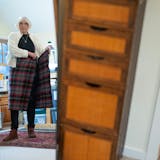Despite widespread discontent with the state of the project, the Rochester City Council voted Wednesday to approve a patchwork approach to smooth over concerns about the accessibility of the city’s redesigned Peace Plaza.
“At this point, not having a great solution and a big bucket of money just to throw at something, I do feel it’s our best option at the moment,” said Council Member Andy Friederichs.
The resolution authorized the city to begin turning over swaths of pavers with raised letterings on the plaza that disability advocates say have become tripping hazards. To pay for the modifications, the city will use $175,000 of state aid earmarked though the Destination Medical Center initiative.
The raised pavers, part of a poetry installation included in the $19.4 million renovation of Peace Plaza, have received significant backlash over the past two years from community members concerned about the safety risks.
While city officials initially defended the design, noting it complied with Americans With Disabilities Act standards, they later concluded modifications were needed to improve accessibility on the plaza. Those changes will include flipping over some of the raised pavers to widen the smooth pathway around the plaza while still preserving the majority of the art installation.
“For the most part, people are experiencing it in a fairly positive way,” Deputy City Administrator Cindy Steinhauser told the council. “But that’s not good enough. We need to make sure everybody is experiencing it in a way that they are comfortable and encouraged to continue to want to come down.”
Council members were not entirely confident in the city’s plans. Several questioned whether the changes do enough to ease concerns about pavers settling and becoming uneven.
Council Member Norman Wahl, who joined Shaun Palmer in voting against the proposal, said it was time to move on from the design, even if that meant prolonging construction on the plaza.


